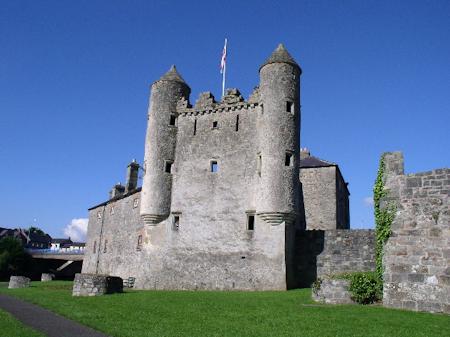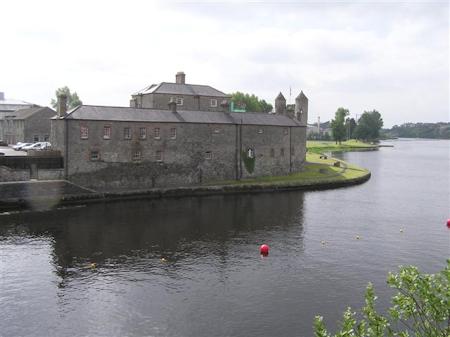
Enniskillen Castle
Enniskillen Castle is situated in a strong defensive position beside the River Erne and commands one of the few passes into Ulster. Originally constructed by the Maguire Clan to defend their territory it is still in use today as a museum.
Hugh 'The Hospitable' Maguire is credited with building the first castle at Enniskillen sometime in the early 15th Century. The first record of it occurs in the Annals of Ulster when Hugh's brother Thomas was held prisoner here by Domnall Maguire in 1439.
The Maguire's Stronghold
In 1484 the Maguire clan moved their seat to Enniskillen Castle. For the next 150 years the castle became the focus of power in Fermanagh as all but two of the Maguire chieftains came from here.
The original castle was a rectangular four-storey tower house with a parapet and battlements on the top. A 16th Century drawing shows the castle completely surrounded by the River Erne and curtain walls.
In 1589 Hugh Maguire, Lord of Fermanagh inherited Enniskillen Castle. After Scottish settlers started invading Fermanagh, and with no help from the English in stopping them, Hugh Maguire became one of the instigators of the Nine Years War.
Maguire lost Enniskillen Castle in 1594 to Sir William Fitzwilliam, Lord Deputy of Ireland after an 8 day siege. He spent years trying to take the castle back, but after he was killed in 1600 his estates in Fermanagh went to the crown for good.
Plantation Castle
In 1607 Enniskillen Castle came into the possession of Sir William Cole. The castle was in quite a sorry state by this point. The years of fighting had taken their toll and Hugh's brother Cuchonnacht Maguire had managed to severely damage it in 1602.
Cole was charged with the restoration of the castle and its conversion to a garrison fort.
He made quite a number of changes to the medieval castle, many of them an echo of Scots Baronial style. Its keep was reduced from four storeys to three. He rebuilt the wall and added a parapet and wall-walk. In 1609 he added the attractive Watergate. It has two bartizans and carved corbels.
In 1689 under Sir Albert Cunningham, a regiment of cavalry was raised which based itself at Enniskillen Castle. It was known as the 6th Inniskilling Dragoons and it became one of the most famous cavalry regiments in the British Army. They served at some of the most notable battles in British history including the Battle of the Boyne, Battle of Waterloo and the Battle of Balaklava.
At the end of the eighteenth Century the castle was remodelled again as it was converted to a military barracks.
Castle Museum
In 1976 Fermanagh District Council established the Fermanagh County Museum at Enniskillen Castle. The museum collections tell the story of the castle from its early days as a Maguire fortress along with exhibitions on the history and culture of Fermanagh.
The castle is also home to The Inniskillings Museum which houses uniforms, weapons and medals telling the story of the Dragoons right back to the 17th Century.
The museum hosts a range of exhibitions of local and national interest. It arranges events throughout the year including craft demonstrations, story-telling events, Living History events, and a programme of family entertainments.
Facilities available at the castle include toilets, baby-changing facilities, a cafe and shop as well as guided tours, good disabled access and a study area.
Status: Museum / Heritage Site
Owner: Fermanagh District Council
Tel: +44 (0) 28 66 325000
Email: castle@fermanagh.gov.uk
Website: www.enniskillencastle.co.uk
Opening Times: Open Daily Mon 2pm-5pm / Tue-Fri 10am-5pm / Sat Apr-Oct 2pm-5pm Nov-Mar Closed / Sun 2pm-5pm


The Watergate at Enniskillen Castle

Looking across the River Erne to the castle